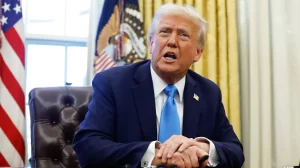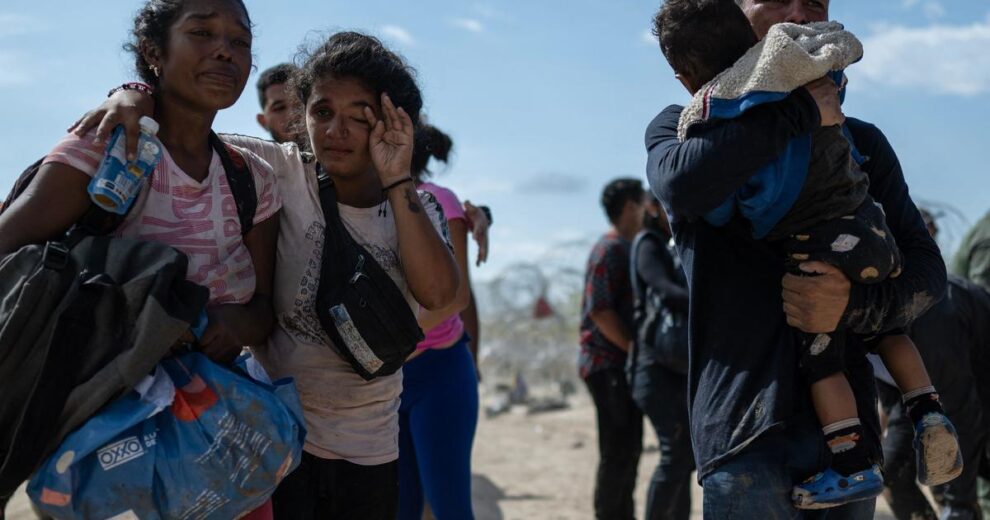Washington — A sharp increase in Venezuelan arrivals is contributing to a recent spike in migration along the U.S. southern border, highlighting the limited resources and policy options available to American officials for responding to an unprecedented refugee crisis in the region.
More than 7.7 million people have fled Venezuela in recent years to escape its precipitous economic collapse and authoritarian rule — the largest displacement crisis ever recorded in the Western Hemisphere. It’s also currently the largest migrant exodus globally, now bigger in scale than the number of registered refugees from war-torn Ukraine and Syria, according to estimates compiled by the United Nations.
The majority of displaced Venezuelans have settled in other South American countries, mainly Peru and Colombia, which has hosted nearly 3 million migrants. But more Venezuelans are leaving those countries with deteriorating economies or Venezuela itself to travel to the U.S.-Mexico border, where illegal crossings have reached near-record levels this month.
In August, U.S. Border Patrol agents processed 22,090 Venezuelan migrants who entered the U.S. illegally — a 93% increase from July, federal data show. Border crossings by Venezuelans have continued to increase in September. The daily average of Venezuelans crossing the U.S. border surpassed 2,000 this past week, nearly tripling the average of 713 in August, according to internal federal data obtained by CBS News.
Tens of thousands of additional Venezuelans are on their way to the U.S. Once an impenetrable jungle, Panama’s Darién Gap is seeing large numbers of U.S.-bound Venezuelan migrants cross its rugged and roadless terrain each month. In August alone, nearly 82,000 migrants, 77% of them from Venezuela, crossed that jungle, an all-time monthly high.
The influx in arrivals of Venezuelan migrants has strained resources in Texas border towns like Eagle Pass and El Paso, as well as in larger cities like Chicago and New York. Officials there have struggled to house tens of thousands of newcomers in hotels, shelters and other facilities, such as police stations. Without any ties to the U.S., many Venezuelans have relied on local services to a greater extent than other migrants.
“It’s really survival migration from Venezuela,” said Andrew Selee, president of the Migration Policy Institute, a U.S.-based nonpartisan research organization. “Some of it is political persecution, but most of it is just basic nutrition and health care and public services that have collapsed. It’s a societal collapse.”
A dramatic shift in migration flows
The marked jump in Venezuelan migration to the U.S. is a significant blow for a strategy implemented by the Biden administration last fall that dramatically reduced the number of migrants from Venezuela entering the country illegally.
In Oct. 2022, the Biden administration began allowing some Venezuelans to fly to U.S. airports if American-based sponsors agreed to support them. It simultaneously started expelling some Venezuelans to Mexico if they crossed the U.S. southern border illegally.
In January, the administration expanded the sponsorship program to include migrants from Cuba, Haiti and Nicaragua, and started expelling some border-crossers from those countries to Mexico. It also unveiled a process that is now allowing tens of thousands of migrants to be processed at official ports of entry along the southern border after securing appointments through a smartphone app.
The number of Venezuelans apprehended by Border Patrol plummeted after these policies took effect, falling from a record high of nearly 34,000 in Sept. 2022 to a two-year low of fewer than 1,500 in February. However, illegal crossings by Venezuelans spiked this spring, reaching 30,000 and 28,000 in April and May. Now, they are on track to match or surpass a monthly record this month.
It’s not the first time U.S.-bound Venezuelan migration has shifted rapidly. Illegal crossings along the southern border by Venezuelan migrants dropped from 22,800 in January 2022 to 3,000 in February 2022 after Mexico ended visa-free travel for Venezuelans at the request of the U.S. But that number rebounded that summer after Venezuelans began crossing the Darién Gap in large groups.
The impact of the Biden administration’s “carrots-and-sticks” strategy has been more pronounced and prolonged for other nationalities. Illegal border entries among Cubans, Haitians and Nicaraguans — who also have access to the sponsorship program — have remained significantly lower than the record levels seen in 2021 and 2022. In August, Border Patrol reported apprehending 756 Cubans, 604 Nicaraguans and zero Haitians, the latter being an unprecedented development in recent history.
Selee, the migration expert, said Venezuelans, by and large, are more predisposed to leave their home country or third countries like Colombia to reach the U.S. because “they see no chance of returning to Venezuela” due to the dire conditions there. Venezuela’s refugee crisis, with millions of Venezuelans in other countries, is also much larger in scale than the recent exodus from Cuba, Haiti and Nicaragua, which have also been plagued by political and economic turmoil.
While more than 61,000 Venezuelans have arrived in the U.S. legally under the sponsorship program, many others may not qualify for the policy because they lack U.S. sponsors or passports. Hundreds of thousands of migrants have also applied for the program, even though there’s a 30,000 cap on approvals each month across all nationalities. The mounting case backlog has resulted in significant processing delays.
Limited policy options for the U.S.
The main factor complicating the U.S. government’s response to illegal border entries by Venezuelans is the strained diplomatic relationship with Venezuela’s socialist government, which faces U.S. sanctions due to its human rights abuses and repressive policies.
While the U.S. regularly deports migrants to countries in Central America and other parts of the world, Venezuela has not accepted official U.S. deportations for years. Such deportations would also likely be decried by progressive advocates and Democrats due to the deteriorating situation in Venezuela.
In fiscal years 2021 and 2022, when the Border Patrol apprehended 235,038 migrants from Venezuela who crossed the southern border illegally, U.S. Immigration and Customs Enforcement reported carrying out 352 deportations of Venezuelans, according to agency data. Since last fall, Mexico has accepted some returns of Venezuelans apprehended by the U.S., but only in limited numbers.
Republican lawmakers have pushed President Biden to reinstate a Trump-era program that required migrants to wait in Mexico while their asylum cases were reviewed, but his administration has rejected that policy on humanitarian grounds. Mexico’s government has also opposed its revival.
Faced with limited policy options and intensifying pressure from cities asking for migrants to be allowed to work more quickly, the Biden administration last week offered Temporary Protected Status to an estimated 472,000 Venezuelans in the U.S., most of whom entered along the southern border. The move will allow those Venezuelans who arrived before July 31 to apply for work permits and deportation protections.
There’s some internal concern within the U.S. government that the TPS expansion will encourage even more Venezuelans to come to America, though Venezuelan arrivals along the southern border and the Darién Gap had already increased sharply before the decision.
In a statement last week, Secretary of Homeland Security Alejandro Mayorkas warned Venezuelans outside of the U.S. that they were ineligible for TPS and would be “removed” if they entered the country unlawfully. He did not say where they would be removed to.
Source : CBS































